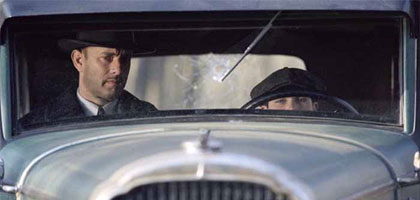
Road to Perdition
USA 2002

Reviewed by John Wrathall
Synopsis
Our synopses give away the plot in full, including surprise twists.
A small town in the Midwest, 1931. Twelve-year-old Michael Sullivan Junior (Tyler Hoechlin) wonders what sort of work his father, Michael (Tom Hanks), does for Irish gang boss John Rooney (Paul Newman). One night when his father goes out on business, Michael Jr hides in the car and sees Rooney's violent son Connor (Daniel Craig) kill fellow gangster Finn McGovern (Ciaran Hinds). In an attempt to cover up his crime, Connor tries to have Michael and his son killed, but kills the boy's mother and younger brother instead. With his son in tow, Michael drives to Chicago to find out whose side Al Capone's right-hand man Frank Nitti (Stanley Tucci) will take. Nitti, eager to protect his interests, sides with the Rooneys. Michael and son head for the Kansas town of Perdition, where Michael Jr will be safe with his aunt. But Nitti's hit man Maguire (Jude Law) catches up with them. Michael and his son escape. Realising he must force Capone to stop protecting Connor, Michael robs the banks where Capone's dirty money is stashed. When the mob's accountant Rance (Dylan Baker) is sent to withdraw the money, Michael tracks him down, only to be ambushed by Maguire. Michael escapes, wounded but in possession of Capone's accounts. After recovering at a farm, Michael confronts John with evidence that Connor has been stealing from him. But John refuses to give up Connor. Michael ambushes and kills John then, tipped off by Nitti, finds and kills Connor. He takes his son to Perdition, where Maguire is waiting. Maguire shoots Michael. Michael Jr pulls a gun on Maguire but can't bring himself to shoot. Michael shoots Maguire and dies knowing his son won't be following in his violent path.
Review
Few directors have caused such a sensation with their first film as Sam Mendes did with American Beauty: over $100 million at the US box office, five Oscars, a direct ticket to the sort of colour-supplement celebrity most directors never attain. It stands to reason, therefore, that few directors' second films have so much to live up to. The good news is that Road to Perdition, his Prohibition-era saga of fathers and sons, contains more than enough brilliance to confirm that American Beauty wasn't a flash in the pan.
Mendes is a natural film-maker; again and again, the key dramatic moments in Road to Perdition are visual, and all the more powerful for it. Take the close-up of Connor Rooney, just after his father, gang boss John, has publicly humiliated him for killing an underworld rival. As the camera lingers on Connor's face, over his shoulder we see John leave the room with his arm round his right-hand man and surrogate son Michael Sullivan; simply by pulling focus from John and Michael back to Connor, without a word being spoken, Mendes shows us Connor's furious jealousy of Michael, and hints at his decision to kill his rival, thus setting the plot in motion. A few minutes later, when Connor is fleeing Sullivan's house after killing his wife and younger son, he is spotted by the elder son, Michael Jr. Connor looks straight at Michael Jr through a glass door, but doesn't see him: instead he is looking at his own reflection. This isn't just a plot point, explaining how Michael Jr escapes the massacre, but a powerful symbolic pairing of the bad son and his mirror image, the good son - all in one shot. There are a dozen more moments just as extraordinary. With the theme (a son realising his father has feet of clay), the setting (Chicago and its environs in 1931) and style (gangsters with Tommy guns) all as old as the hills, it's to Mendes' credit that Road to Perdition never seems secondhand. But if, moment by moment, this has the makings of a great film, taken as a whole it's somehow less than the sum of its parts. There's a feeling of overkill about it: Mendes lays on his set pieces with such bravura that, when the film reaches the point where it really needs one - the climactic shoot-out between Michael Sullivan and John Rooney - he can't top what's gone before, leaving us with a damp squib as he turns up Thomas Newman's plaintive score and fades out the sound effects while bodies stagger balletically in the rain.
This need to charge every moment with maximum resonance also has an adverse affect on the performances. Tom Hanks is fine in his post-Private Ryan mode as the unflinching, stoical hit man Sullivan. But when the plot requires, it takes only one chance remark from an old woman (to the effect that his son dotes on him), for him to be transformed into the twinkly-eyed, caring Hanks of old, telling his son about his feelings for him. Each moment works on its own terms, but does it add up to a believable human being? (I had the same problem with American Beauty: as Lester, Kevin Spacey was absolutely terrific in two modes, as downtrodden nerd and cool, wry observer, so much so that the two halves of his character never joined up into one whole person.)
Perhaps surprisingly for such a prestige production, Road to Perdition is based on a graphic novel. What it shares with other, very different comic-book adaptations (say the Batman movies) is its totally designed look. Not a detail is out of place. Every frame is a picture. Since American Beauty Mendes has loudly trumpeted his debt to his veteran DoP Conrad L. Hall, and here he seems to be repaying it, giving Hall a free hand to paint with light, creating a gorgeous palette of dark greys, browns and greens. The film looks perfect, but at the same time so studied it's somehow airless, drowned in quality, almost to the point of kitsch. Though the gangster setting, the stylisation and the concentration on dynamic set pieces might be reminiscent of Miller's Crossing, there's none of the Coens' narrative or comic waywardness to loosen it all up.
Instead, it's crying out for a hint of humour, bad taste or real pain to break through the immaculate surface. Ultimately the film it most recalls is The Shawshank Redemption, another fable so solemnly tasteful in its recreation of a period and a genre that the brutality of the story was somehow glossed over. This overpowering polish seems all the more perverse when applied to a gangster film set in 1931. The authentic gangster movies of that era - Little Caesar, The Public Enemy, Scarface - had none of the technical perfection of a 21st-century DreamWorks production. What they did have, however, were an urgency and a bitter flavour of reality that Road to Perdition can only dream of.
Credits
- Director
- Sam Mendes
- Producers
- Richard D. Zanuck
- Dean Zanuck
- Sam Mendes
- Screenplay
- David Self
- Based on the graphic novel written by
- Max Allan Collins
-
and illustrated by
- Richard Piers Rayner
- Director of Photography
- Conrad L. Hall
- Editor
- Jill Bilcock
- Production Designer
- Dennis Gassner
- Music
- Thomas Newman
